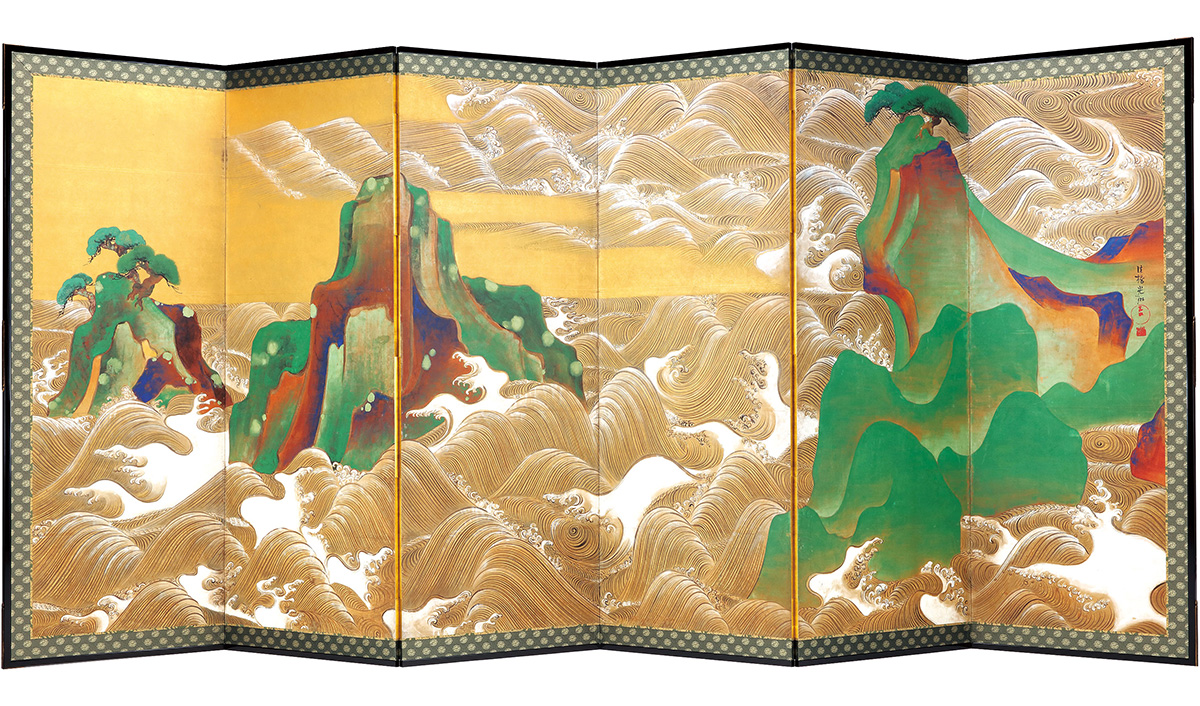News Release
April 25, 2024
Canon Inc.
Tsuzuri Project donates to Kyoto City University of Arts a high-resolution facsimile of Ogata Kōrin's "Waves at Matsushima," to be displayed at an area of the university open to the public
TOKYO, April 25, 2024— Canon Inc. announced today that the Tsuzuri Project (officially, the Cultural Heritage Inheritance Project), a joint project organized by Kyoto Culture Association (NPO) and Canon, have donated to Kyoto City University of Arts a high-resolution facsimile of "Waves at Matsushima" by Ogata Kōrin —the original of which resides in the collection of the Museum of Fine Arts in Boston, Massachusetts, U.S.A. —as part of the project's Stage 15. The facsimile will be displayed at an area of the university which is open to the public.

All photographs ©2024 Museum of Fine Arts, Boston. Reproduced with permission
Ogata Kōrin, who was active in the mid-Edo Period, is known as the master of the Rinpa school. He had a deep admiration for Tawaraya Sōtatsu, one of the founders of the Rinpa school who was active in the early Edo Period, and left behind several pieces which referenced works by Sōtatsu including this piece. Based on the right-hand screen of Sōtatsu’s “Waves at Matsushima1,” but blended with Kōrin’s unique interpretation, it features even more dynamic expressions as demonstrated by the movement of the waves. The original folding screen was purchased by American art historian Ernest Fenollosa during his visit to Japan and has resided at the Museum of Fine Arts in Boston since 1911.
Canon’s EOS R5 full-frame mirrorless camera was used to capture images of the original work, after which Canon applied its proprietary color matching system and image processing. The facsimile was then output using large-format inkjet printers with 12-color pigment ink. Finally, expert Kyoto craftsmen applied gold to the facsimile and mounted it on folding screen frames, completing an extremely accurate reproduction of the original work.
The Tsuzuri Project will donate this piece to Kyoto City University of Arts in the hopes that the many students studying the arts there will play major roles on the world stage much like Ogata Kōrin, who was born and raised in Kyoto and went on to become an internationally recognized painter. The facsimile will be displayed2 in an area of the university that is open to the public, which will allow many people from both Japan and overseas including local residents to appreciate the artwork up-close and free from a glass case. There are also plans to use the artwork in classes held at the university and events held in collaboration with the local community.
- 1
Produced as the third Tsuzuri Project work in 2009
- 2
Available for viewing in front of the library at the Research Institute for Japanese Traditional Music, Building A, 1st floor, Mon.-Fri. from 8:30AM to 5:15PM (viewings unavailable Sat., Sun. and public holidays and when artwork is on loan)
About the Tsuzuri Project
The Tsuzuri Project is a joint cultural support activity organized by Kyoto Culture Association (NPO) and Canon in 2007. Many of Japan’s precious historical and cultural assets have limited viewing opportunities, often because they have been moved overseas or are preserved in storage as designated national treasures. The project produces high-resolution facsimiles by combining Canon’s technical expertise in imaging, processing and output with the master craftsmanship of traditional Kyoto artisans. These high-resolution facsimiles are donated to institutions with ties to cultural assets such as shrines, temples, local governments and museums and are available for a variety of purposes including public display and tangible educational materials. So far, a total of 61 high-resolution facsimiles of artwork from artists including Katsushika Hokusai, Tawaraya Sōtatsu, and Ogata Kōrin have been produced.
For more information, please visit the official Tsuzuri Project website: https://global.canon/en/tsuzuri/
